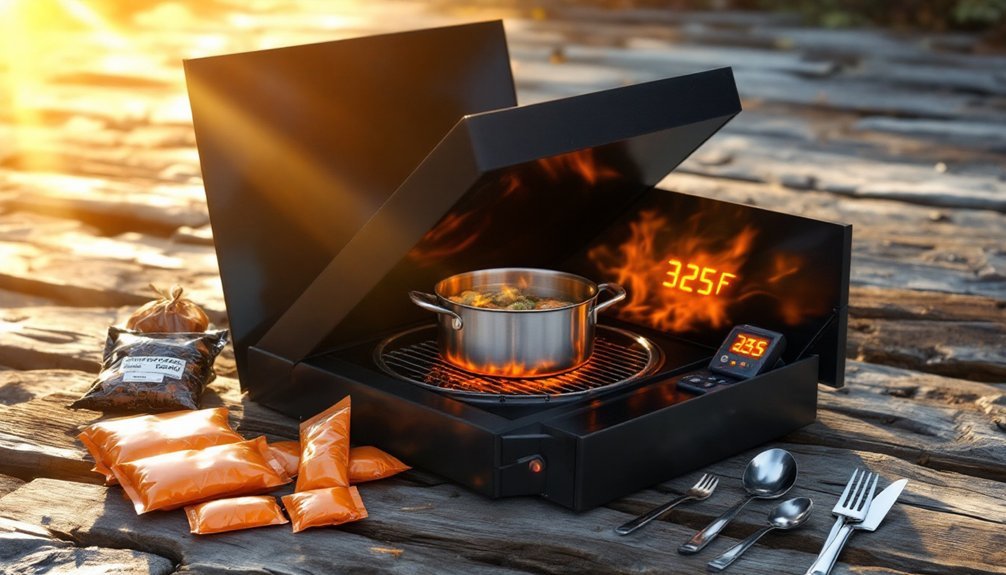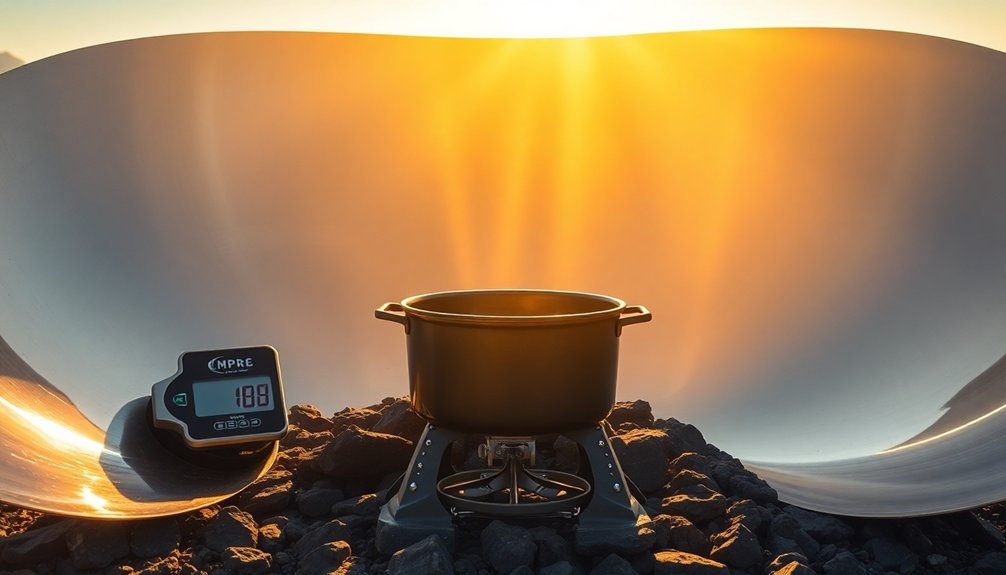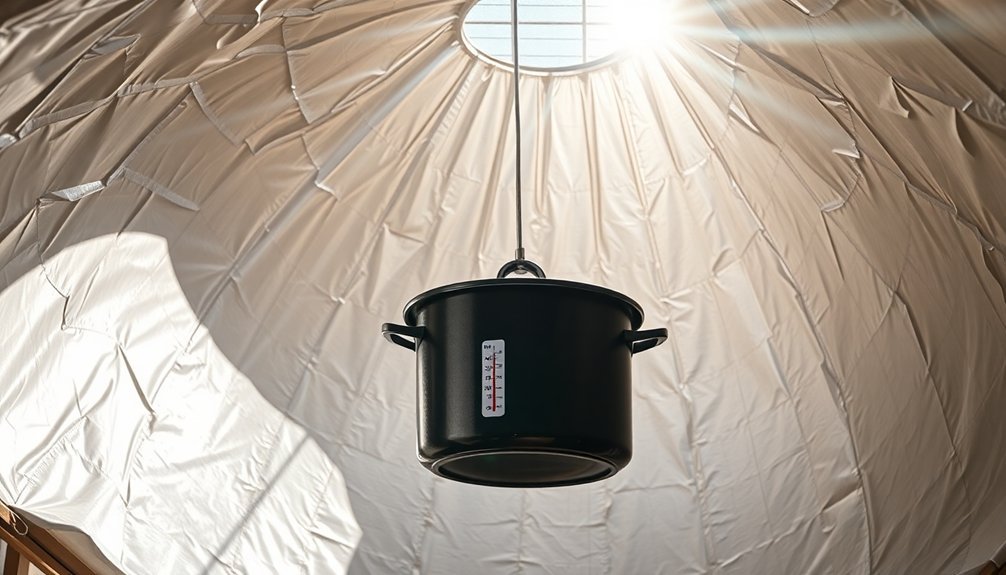When disaster strikes, you'll need more than just stored food to survive – you'll need a reliable way to cook it. The right solar cooking kit can mean the difference between a hot, nourishing meal and raw rations during an emergency. Whether you're preparing for natural disasters, power outages, or off-grid situations, these seven top-rated solar cooking solutions offer distinct advantages that could prove essential for your family's survival. Let's explore your best options for staying self-sufficient when traditional cooking methods aren't available.
Coghlans Stove
The Coghlans Stove stands out as a reliable choice for outdoor enthusiasts and emergency preppers who need a compact, versatile cooking solution. You'll appreciate its fold-flat design that fits easily in your backpack or emergency kit, measuring just 6.5 x 6.5 x 5 inches.
With its coated steel construction, you can count on this stove to support heavy pots without wobbling. It's compatible with multiple fuel sources, including canned fuel and solidified alcohol. The efficient airflow design guarantees consistent burning, even in windy conditions. While some users note the $20 price tag seems high, the stove's durability and 4.5-star rating from over 4,800 customers justify the investment.
Best For: Outdoor enthusiasts, campers, and emergency preppers seeking a lightweight, portable stove that's easy to pack and compatible with multiple fuel sources.
Pros:
- Compact and lightweight design with fold-flat functionality for easy storage and transport
- Versatile fuel compatibility including canned fuel, solidified alcohol, and natural materials
- Sturdy steel construction with stable base for supporting heavy pots
Cons:
- Relatively high price point for a simple design at around $20
- Some users report issues with a lopsided door that needs adjustment
- Limited cooking surface area due to compact size
Ready Hour Emergency Meal Entrées (120 Servings)
Families seeking extensive emergency meal solutions will appreciate Ready Hour's 120-serving entrée kit. This all-encompassing package offers 22 resealable pouches with non-perishable meals that'll last 25 years. You'll find 4-8 servings per packet, all stored in a flood-safe container with a handle for easy transport.
While you might need to add seasoning to enhance the flavors, these meals provide complete nutrition with protein and variety. At roughly $1 per serving, you're getting good value compared to other emergency food options. The sturdy packaging guarantees your investment stays protected, making it an ideal addition to your solar cooking preparedness setup.
Best For: Families and outdoor enthusiasts seeking a comprehensive, long-term emergency food solution with reliable packaging and convenient serving sizes.
Pros:
- Outstanding 25-year shelf life ensures long-term emergency preparedness
- Sturdy, flood-safe packaging with convenient handle for transportation
- Good value at approximately $1 per serving with variety of meal options
Cons:
- Meals may be bland and require additional seasoning
- Initial investment cost might be high for some budgets
- Serving sizes per packet vary (4-8 servings), which may complicate meal planning
Ready America 72 Hour Deluxe Emergency Kit for 2 Persons
Designed for two-person households, Ready America's 72 Hour Deluxe Emergency Kit delivers extensive disaster preparedness in a compact backpack.
You'll find essential survival supplies including two 2400-calorie food bars, six water pouches, and purification tablets with a 5-year shelf life. The kit's multi-function hand-crank power station provides light, radio, phone charging, and a siren – one minute of cranking yields 30 minutes of light or 15 minutes of radio use.
The 10-pound kit includes a 33-piece first aid kit, hygiene supplies, dust masks, survival blankets, and a multi-tool. With a 4.7-star rating, it's ranked #4 in home emergency survival kits.
Best For: Couples or two-person households seeking a comprehensive, pre-packed emergency survival kit that provides essential supplies for a 72-hour period.
Pros:
- All-in-one solution with food, water, first aid, and emergency power in a portable backpack
- Multi-function hand-crank power station eliminates need for batteries and provides essential communications
- Long 5-year shelf life for food and water supplies
Cons:
- Limited food and water supply for only 72 hours
- 10-pound weight may be heavy for some users to carry
- First aid kit contains only basic supplies for minor injuries
Augason Farms 30-Day Emergency Food Supply Kit
Survivalists seeking a complete emergency food solution will find excellent value in Augason Farms' 30-Day Emergency Food Supply Kit. You'll get 200 servings packed in a 5-gallon bucket, delivering over 1,200 daily calories through easy-to-prepare meals.
At around $100, you're paying just $3.70 per day for a variety of dishes like creamy potato soup. While the Mylar packaging is thinner than competitors', it's well-sealed and maintains a 20+ year shelf life. You can enhance the meals by adding your own canned meats for extra protein. The included 30-day meal planner helps you organize your emergency food strategy efficiently.
Best For: Emergency preparedness-minded individuals and families seeking a cost-effective, long-term food storage solution with easy-to-prepare meals.
Pros:
- Excellent value at $3.70 per day for 200 servings of emergency food
- Long 20+ year shelf life ensures reliable food security
- Includes convenient 30-day meal planner and simple preparation instructions
Cons:
- Mylar packaging thinner than competing products
- May need supplemental protein sources for complete nutrition
- Meal planning guide inconveniently placed at bottom of bucket
Tiny Survival Guide: Emergency & Disaster Preparedness Micro-Guide
When disaster strikes, having compact survival knowledge at your fingertips can mean the difference between life and death. The Tiny Survival Guide packs essential survival information into a palm-sized, waterproof format you can carry anywhere.
You'll find 101 illustrations, 67 survival skills, and 175 expert tips covering everything from active shooter situations to basic first aid. The guide's durable design helps you combat brain fog during emergencies while providing critical instructions for food, water, shelter, and fire. Despite its small print, the content remains clear and accessible, making it an invaluable addition to your emergency preparedness kit.
Best For: Outdoor enthusiasts, travelers, and safety-conscious individuals who want comprehensive emergency preparedness information in an ultra-portable format.
Pros:
- Extremely compact and portable design fits easily in pockets, bags, or wallets
- Comprehensive coverage of survival skills with 101 illustrations and 175 expert tips
- Waterproof and durable construction ensures reliability in emergency situations
Cons:
- Small print size may be difficult to read for some users
- Cannot provide the same depth of information as a full-sized survival guide
- Requires familiarization with content before emergency situations to be most effective
First My Family 4-Person Emergency Survival Kit with LifeStraw
This extensive 4-person survival kit offers an instant emergency solution that exceeds Red Cross guidelines for disaster preparedness. You'll get a durable, waterproof backpack packed with essential supplies for 72 hours of survival during hurricanes, earthquakes, or other disasters.
The kit includes food rations with a 5-year shelf life and quality emergency gear, though you'll want to customize it with additional supplies like a solar charger and emergency radio. While some users note discrepancies in first aid piece counts, the backpack's spacious design allows room for personal items. Consider covering the visible branding to maintain discretion during emergencies.
Best For: Families seeking a comprehensive starter emergency kit that meets disaster preparedness guidelines and serves as a foundation for a customized 72-hour survival pack.
Pros:
- High-quality, waterproof backpack with excellent organization and room for additional supplies
- Exceeds Red Cross guidelines with essential emergency supplies and 5-year shelf life food rations
- Versatile usage for various emergency scenarios including natural disasters, camping, and road trips
Cons:
- Some users report inconsistencies in first aid kit component counts
- Visible branding on the backpack could draw unwanted attention in emergency situations
- Basic food rations may need supplementation for complete 72-hour coverage
DISASTER DECK Emergency Preparedness Reference Cards for Safety and Survival
Emergency preparedness becomes effortless with the DISASTER DECK's compact, waterproof reference cards. You'll have instant access to essential information covering 12 major disasters, from wildfires to tsunamis, all color-coded for quick reference during critical moments.
The cards fit perfectly in your glove compartment, backpack, or emergency kit, measuring just 3.75 x 2.5 inches. You'll appreciate the included "Be Well" card focused on emotional resilience during crises. Made in the USA, these durable cards have earned a 4.5-star rating from nearly 1,000 users who praise their sturdy construction and readability, even when wet.
Best For: Individuals and families seeking a portable, comprehensive emergency reference guide that's especially valuable for travelers, new drivers, and anyone who wants quick access to disaster preparation information.
Pros:
- Waterproof and durable construction makes it reliable in harsh conditions
- Compact size fits easily in emergency kits, glove compartments, or backpacks
- Includes mental wellness guidance alongside practical emergency instructions
Cons:
- Information may be too basic for experienced emergency preppers
- Limited to 12 specific disaster scenarios
- Price point may be high for what is essentially a set of information cards
Factors to Consider When Choosing an Emergency Solar Cooking Kit for Disaster Preparedness
Selecting the right emergency solar cooking kit means evaluating essential features that'll determine your success during critical situations. You'll need to assess portability, heat output, weather resistance, cooking capacity, and whether the kit works with alternative fuel sources when sunlight isn't available. These key factors will directly impact your ability to prepare meals safely and efficiently during emergencies, making careful consideration of each element vital to your disaster preparedness strategy.
Portability and Storage Space
When considering a solar cooking kit for your disaster preparedness plans, portability and storage space should rank among your top priorities. You'll want a kit that folds flat or disassembles easily, fitting neatly into your backpack, vehicle, or emergency storage containers.
Look for lightweight designs that won't weigh you down when you're carrying other essential supplies. The kit's dimensions should be compact enough to integrate seamlessly with your existing preparedness gear. If it comes with its own carrying case or storage bag, you'll find it easier to keep components organized and protected. Additionally, components that can stack or nest together will help you maximize your limited storage space. These space-saving features guarantee you're ready to cook whenever and wherever you need to.
Heat Output Requirements
Since cooking performance directly depends on heat generation, understanding your solar cooking kit's temperature capabilities is essential for emergency preparedness. You'll need a cooker that reaches at least 200°F to guarantee your food cooks thoroughly, while models that can achieve 400°F offer more versatility in emergency situations.
Look for a cooker with reflective surfaces and adequate size to capture maximum sunlight. The design should include adjustable positioning to track the sun's movement, as this greatly impacts heat output. Remember that even efficient solar cookers typically require 2-4 hours of cooking time, depending on sunlight conditions.
When evaluating options, prioritize models that maintain consistent heat levels. A cooker's ability to retain heat will determine how reliably you can prepare meals during emergencies.
Weather Resistance Features
Reliable weather resistance features form the backbone of any effective emergency solar cooking kit. You'll want to guarantee your kit includes durable materials that can withstand rain, wind, and UV exposure, as these elements can greatly impact your cooking success during emergencies.
Look for models with high-quality reflective surfaces that maintain efficiency even on cloudy days. The kit's construction should be robust enough to resist strong winds without tipping over. You'll also need waterproof components to protect essential cooking elements from unexpected rain and moisture. Don't overlook thermal insulation – it's vital for maintaining heat efficiency in challenging weather conditions. When evaluating different kits, prioritize those with weather-resistant features that allow for year-round use, regardless of the environmental conditions you might face.
Cooking Capacity Needs
Beyond weather protection, the right cooking capacity can make or break your emergency preparedness plan. You'll need to calculate how many people you're planning to feed during emergencies, as this directly impacts the size of solar cooking kit you should choose.
When selecting your kit, focus on versatility. You'll want a system that can handle various cooking methods – from boiling water to simmering stews and even baking. Look for models with adjustable cooking surfaces or multiple chambers, which let you prepare different foods simultaneously. The cooking surface area is essential; larger surfaces accommodate bigger pots or several smaller ones.
Don't forget to factor in cooking time. Since solar cookers rely on daylight, knowing how quickly your kit reaches ideal temperature will help you plan daily meal preparations effectively.
Fuel Source Compatibility
Smart fuel source compatibility stands at the core of effective emergency solar cooking. You'll want to choose a kit that's versatile enough to work with multiple fuel options, guaranteeing you're never left without a way to cook during disasters.
When selecting your emergency solar cooker, look for models that can effectively harness solar energy even in less-than-ideal conditions. The best kits feature dual-fuel capabilities, allowing you to switch to alternatives like wood, propane, or solid fuel when sunlight is limited. Focus on designs that maximize sunlight absorption and heat retention through efficient engineering.
Your chosen kit should support various cooking methods, from boiling to baking, making it a reliable tool for preparing different meals. This adaptability assures you're well-equipped to handle any emergency situation, regardless of available fuel sources.
Frequently Asked Questions
How Long Can Solar-Cooked Food Be Safely Stored Without Refrigeration?
You shouldn't store solar-cooked food longer than 2 hours at room temperature. If it's over 90°F outside, limit storage to 1 hour. For safety, eat your food immediately after cooking to avoid bacteria growth.
Can Solar Cookers Work Effectively in Cold Weather Conditions?
Yes, you'll find solar cookers work in cold weather if there's direct sunlight. They don't rely on air temperature but on solar radiation. However, you'll need more cooking time and good insulation in chilly conditions.
What Backup Cooking Methods Should I Have if Solar Cooking Fails?
You'll want multiple backup options: a portable propane stove, alcohol burner, or rocket stove for fuel-based cooking. Keep a charcoal grill and dry fuel ready. Don't forget matches and fire starters.
How Do I Clean and Maintain My Solar Cooker After Frequent Use?
You'll need to wipe down reflective surfaces with a soft cloth, remove food residue immediately after use, store your cooker in a dry place, and check for damage to seals or reflectors regularly.
Can Solar Cookers Purify Contaminated Water During Emergencies?
Yes, you can purify water using your solar cooker. Just heat the contaminated water to a rolling boil for at least 1 minute. This'll kill harmful bacteria and pathogens, making it safe to drink.





Leave a Reply